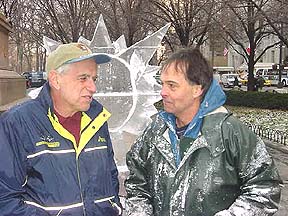Grand Army Plaza
The Daily Plant : Thursday, December 28, 2000
A SOLSTICE LANDSCAPE—SUN AND SNOW

Grand Army Plaza was the site of Parks' annual Winter Solstice celebration December 21, 2000. Throughout time, the Winter Solstice has been marked by celebration all over the world, honored with awesome architectural structures like Stonehenge in England and Newgrange in Ireland, and others in North and South America, Asia, Indonesia and the Middle East. On the 21st, one of New York's awesome structures, Central Park, honored this annual landmark in time, the gradual return of the sun.
With candles and wreaths Parkies celebrated the shortest day of the year and welcomed in a season of snow. The use of these objects dates back to the ancient belief that only human rituals could prevent the sun's failing light from disappearing forever. Lush evergreen leaves and bright fire-lit candles were thought to be healing medicine for a sickly sun too weak to shine. People believed it was their responsibility to coax the sun back into the sky and secure a future of brightness.
Commissioner Henry J. (StarQuest) Stern observed that "there is wisdom to the belief that the efforts of people are necessary for the earth. Our efforts on behalf of the environment-its water, grass, ozone and soil, its underground resources and its overland animals-are very important. The traditions of the Solstice originate in the belief that people and nature are partners. In the spirit of this belief, we celebrate." Mrs. Rosenberg's 4th Grade Class, masquerading as mini-suns and moons, gathered round ice sculptor, Roy Churneck, who chiseled a three-foot by three-foot frozen block into the shape of the sun. Then the sun worshippers hurried back inside to warm their hands on cups of hot chocolate.
PARKIES TO RETIRE AFTER 25 YEARS IN LABOR
Of all the people who work in parks, those that labor in them know that playgrounds, gardens, beaches, recreation centers and pools are physical entities and that keeping them alive is a strenuous task. Today, eight laborers will retire. Lawrence Willis, William Benjamin, John Davis, Dennis Quirke, Altion Rosser, the twin brothers Anthony and Louis Catoggio, and James Welsh, President of the Laborer's Union have dedicated a quarter of a century to service and their contributions are greatly appreciated. At a farewell gathering Friday, December 15 at the Five Boro Shops on Randall's Island Commissioner Henry J. (StarQuest) Stern congratulated them and thanked them for their contributions.
THIRTEEN YEARS AGO IN THE PLANT
(Thursday, December 31, 1987)
JOHN MULLALY AND 100 YEARS OF THE BRONX PARKS SYSTEM
A century ago, few persons anticipated the eventual depletion of our open spaces. one such visionary was John Mullaly (1835-1915) -- father of the Bronx Parks system which was officially designated a century ago this year.
Born in Belfast Ireland, Mullaly came to the U.S. as a young man and soon became a special correspondent for the New York Herald. While covering the laying of the first trans-Atlantic telegraph cable (1857-58), he served as secretary to Samuel F.B. Morse, who is credited with developing Morse Code. During a 14-year stint as editor of the Metropolitan Record, then the official organ of the Roman Catholic Church in New York City, Mullaly developed the printing technique of "alumniography."
QUOTATION FOR THE DAY
"Awake my soul, and with the sun
Thy daily stage of duty run."
Thomas Ken (1637-1711)
Check out your park's Vital Signs
Clean & Safe
Green & Resilient
Empowered & Engaged Users
Share your feedback or learn more about how this park is part of a
Vital Park System
